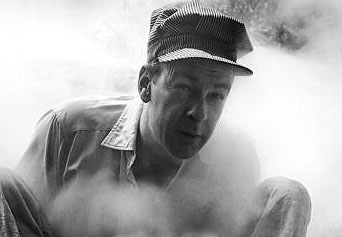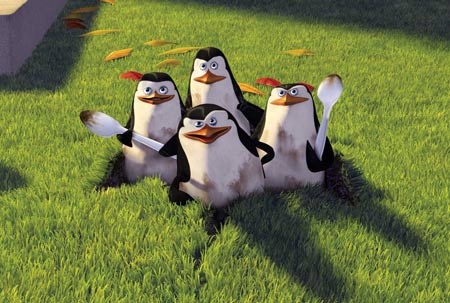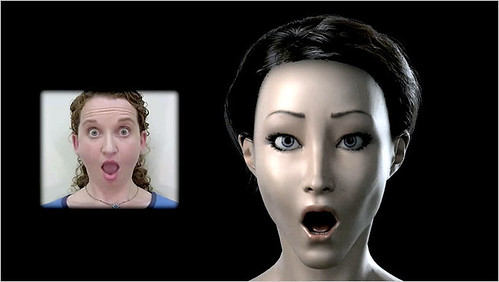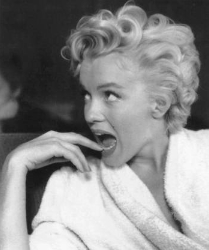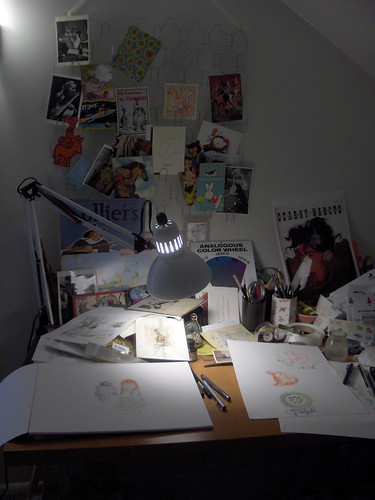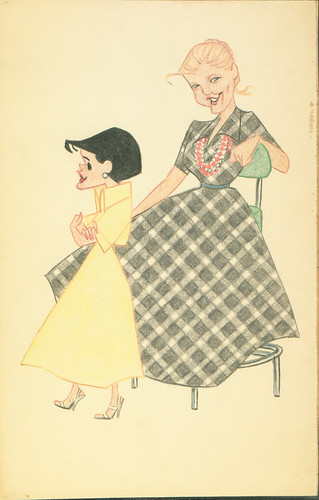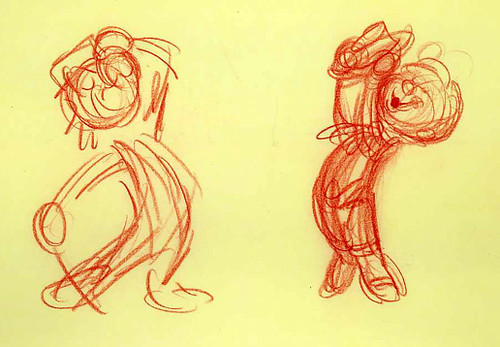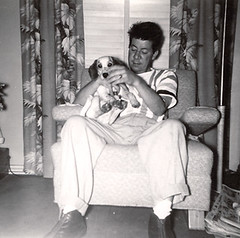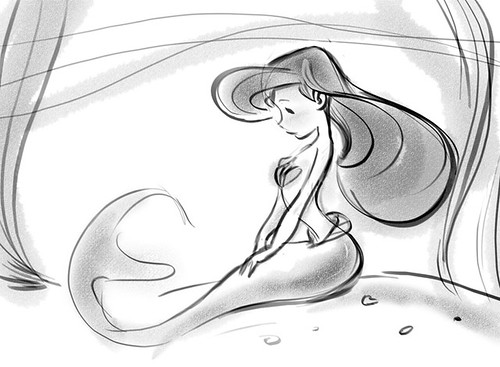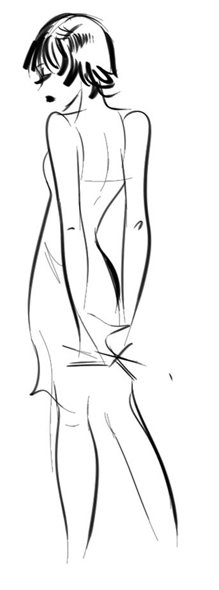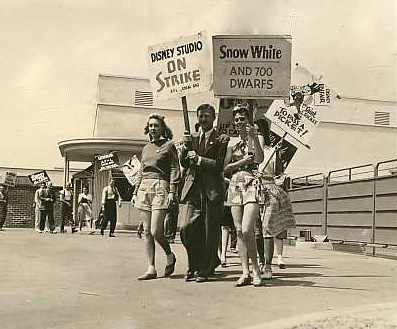 In lieu of a more suitable illustration--here we have two striking women of animation, circa 1941(see Walt's contemporaneous reference to such of his staff below)
In lieu of a more suitable illustration--here we have two striking women of animation, circa 1941(see Walt's contemporaneous reference to such of his staff below)Back from the See Jane/Union "Where The Girls Aren't" panel. Wow. That was a heck of an evening. I felt incredibly proud to share a dais with Brenda, Jill, Dean, Fred and Geena, all moderated cogently and well by Kevin Koch. A lot was said, yet it was obvious that any one of us could have gone on much longer and I was eager to hear more from everyone--especially Dean, Brenda and Jill. 90 minutes and we barely scratched the surface. I feel it was a success. The turnout was great, many more than I expected might attend. Thanks to Kevin for asking me, and thanks especially to the supportive attendees who came and participated. I was thrilled to see some friends I've missed for ages, and very humbled and gratified to hear some kind words about The Blackwing Diaries. Shucks!
I'd carried a book up with me and almost had a perfect moment to read a relevant passage I'd marked, but the moment passed so I'll share it here. Kevin Koch had just alluded to the infamous "no thanks" letter that's been passed around and published, a letter sent in 1939 to a young woman artist who'd inquired about how to get a job as an animator at Disney's. She received a formal reply flatly stating that
"women do not do any of the creative work in connection with preparing cartoons for the screen in making animated cartoons, as that is performed entirely by young men". Of course, this was in fact totally untrue, since there were indeed some few women in the story, visual development and assistant animator areas at the Disney studio at that very moment, but apparently the official line was
don't even think about it--but if you
must, try out for ink and paint. At least they were accurately honest about
that division having nothing to do with the "creative work" of animation.
Yet barely 3 years later, in 1941, his studio full of unrest and at the brink of the strike that would tear apart the old illusion of happy cloudless days, none other than
Walt Disney himself said these words in front of his assembled employees, at a kind of "state of the studio" speech:
..."The girl artists have the right to expect the same chances for advancement as men, and I honestly believe that they may eventually contribute something to this business that men never would or could. In the present group that are training for inbetweens[sic] there are definite prospects, and a good example is to mention the work of Ethel Kulsar and Sylvia Holland on the "Nutcracker Suite", and little Rhetta Scott, of whom you will hear more when you see "Bambi".
...if a woman can do the work as well, she is worth as much as a man"This, from Walt Disney--in
1941! He wouldn't have said it if he didn't believe it. He was a genius, a mercurial character and a product of his age--almost a victorian by birth--yet he cared more than anything else about the end product, the films he was obsessed with making better than anyone else's.
I wish I could have managed to wriggle this stellar quote into the evening, but we had plenty of good discussion without it.
Personally, I come away lost in thoughts of how to best inspire the next generations of artists...why
are so few of the applicants at Calarts or indeed at Disney or Pixar or Dreamworks girls? Is it, as I suspect, largely a matter of ignorance about the possibilities of telling stories and using one's artistic skills in this medium? Does it have anything to do with how few girls are comics geeks in grade school? Is drawing, after all, de-emphasized in school to the point where it's relegated to nothing more than a "hobby" for all but the most fanatical who wield a pencil or pen? Naturally I'm prejudiced in thinking that art should be a crucial part of any child's education; for a century or so it was a sure fire part of a well rounded american child's curriculum. Now I don't think most 7th-12th grade kids even get exposed to studio arts at all--not in public school, anyway. That can't be a good thing.
I could go on and on, and not strictly about girls...but as I said at the panel, these little thoughts are motes floating next to the Titanic-sized context of The Entertainment Industry and Art of animated film & television we work in. I think it does help, somehow, to float some subjects and perspectives out into the open sea of discourse and acknowledge them, adding our own experiences where they might be enlightening. I certainly benefited from what I heard tonight.
Thanks again, everyone.
EDITED TO ADD: The union blog's just posted (10/13) a synopsis of the event with a few photos. I wish it had been better edited, with real rather than remembered quotes. There are three abbreviated statements attributed to me which aren't quite what I said
or how I said it--and for someone who is as in love with words and meaning as I am, it's a bit painful to read. One example: When Brenda Chapman told of being sought out by Joe Ranft specifically to help with the female characters in "Cars"--and when Geena (or Kevin) noted that there was only one female "car" character, I held up my fingers to indicate "two"--also blurting out as it occurred to me: "Isn't it funny?--cars are usually always referred to as
female, as in "She's a cherry!", that kind of thing--they're thought of as feminine, like boats, traditionally. Yet in "Cars" almost all the cars are male...." This off the cuff observation is given in the TAG recap as this:
Jenny Lerew: And aren't cars usually designated female, like ships. But almost all the cars in "Cars" are male. What was a spontaneous thought comes off sounding like a complaint or problem. Not so!
Further, some of the non-verbatim contextual recounting of observations made by the speakers makes use of perjoratives
they in fact didn't use nor flatly imply, as in this: "
In another example of job stereotyping, Jill recalled being assigned sequences involving the character Jessie in Toy Story 2 while she was at Pixar."
While Jill did speak of that, she wasn't in my opinion talking about "stereotyping", not did she use that hugely loaded word. Or is my memory failing me?
Yes, there was very honest and matter of fact noting of the byproducts of working in a mostly male environment. Brenda took some words directly out of my mouth that I was all set to say, in fact--namely, that the guys at Pixar, several of whom I know and who I feel fairly certain are a lot like, well, like
me and my closest [male] friends in the business, do what comes naturally: they write and conceive and draw stories and characters that are dead honest--that come from their own guts and experiences. And they're guys, many of them fathers, all former little boys as I was a former little girl...they naturally(in my opinion)think of a boy's reaction and persona before a girl's, for good reason--they're
boys. That's who they are, that's what they know. And
I often start a new story with the hero being--guess what? A girl. Usually a girl an awful lot like youngest, feisty(not to say bratty), redheaded
me.
Now, stories get embellished and fleshed out, and characters are changed, stretched, gender-bent--even made into another species or
thing--but we all start with what we know best, first. Sometimes we stick to that, because it's the story we want to tell and it works best...or sometimes, as happens, we change a character from a girl to a boy or vice versa, because it
makes a better story. And sometimes we might do something with some of our characters that we aren't aware of, that we'd be enhancing our stories to think again about.
The big point I personally believe--that I will hazard Brenda and Jill do too--is
that's perfectly okay--it's just that as so many of the creators of stories are guys, sometimes the characters' gender and approach, reflecting the guys doing the drawings and thinking, are weighted towards the male end of the balance. That's not to say that a good storyteller--man or woman--can't or shouldn't or wouldn't choose to use whatever or whoever they please for their specific story...I could give concrete examples of what I think are unusually successful, conscious choices, one being all the characters in "Incredibles". But right now this is long enough already, so I'll pass.
A very important observation all three of us, the women on the panel agreed upon was left out of the TAG report: we
all said that we hadn't felt "held back" or hindered as artists due to gender in any obvious, substantial way--that is, not as far as we knew, anyway. In fact, I said that given the tiny numbers of women vs. men at school, the females in the business who've stuck with it have fared better statistically than the men...maybe that means that if you're committed enough to seek out animation as your life's work, when it's already a male-dominated field, you'll just keep at it no matter what-but it also suggests that somewhere, from someone there'll be encouragement and help.
I talked repeatedly about the common goals that I share in story work with my male colleagues...that the aims we have far outweigh the differences. I'd like to have had that quoted. And Geena Davis herself made clear that her interest is simply in a hope for more interesting, reflective and inclusive stories that can be told for
all children to enjoy.
I add these points as the recap as presented by the union blog comes off rather confusingly and certainly doesn't give the tenor of the evening as I experienced it...then again, it is a very very big subject.
I'd want Blackwing readers to know It wasn't any sort of a venting or bashing discussion. I'd likely be unsatisfied with anything but a straight transcript of the evening, but I still feel compelled to note my take on, well, my take. If you've read this far--I owe you some more pith on this blog.
